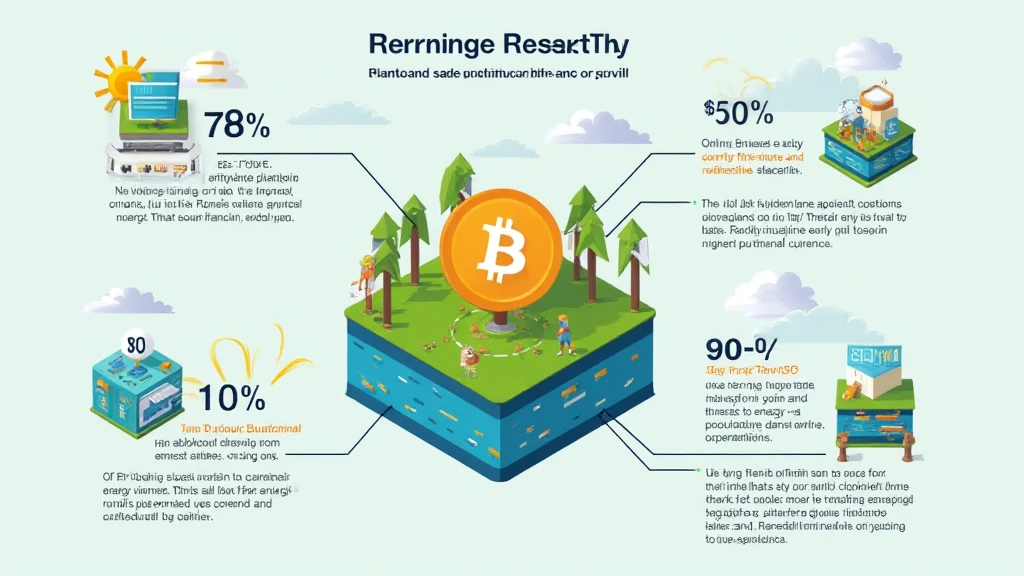Bitcoin Blockchain Energy Policies: Navigating Sustainability in Digital Currency
As cryptocurrencies continue to gain traction, the conversation around their energy consumption has reached a critical point. In 2023, it was estimated that Bitcoin mining operations consumed over 150 TWh of energy, raising concerns over sustainability and environmental impacts. This article explores the intersection of Bitcoin blockchain energy policies, their implications for the ecosystem, and how they can be leveraged for a more sustainable future.
The Current Landscape of Bitcoin Energy Consumption
Bitcoin’s proof-of-work mechanism is often cited as a significant contributor to its energy consumption. To understand the complexities, it helps to draw an analogy: consider Bitcoin mining like a colossal bank vault that requires immense power to maintain security and integrity. Here are some essential statistics:
- In 2023, the energy usage of Bitcoin mining represented approximately 0.6% of the global electricity consumption.
- The carbon footprint of Bitcoin transactions is equivalent to that of the entire nation of New Zealand.
- With increasing regulatory scrutiny, over 30% of Bitcoin mining operations are relocating to regions with renewable energy.
The Role of Energy Policies in Blockchain Development
Energy policies directly influence the Bitcoin blockchain’s sustainability efforts. As more countries enact regulations focused on environmental impact, the need for a cohesive strategy becomes evident. For example, Vietnam has seen a remarkable increase in crypto adoption, with user growth rates hitting 300% in the last two years. This growth drives demand for energy-efficient mining practices.

Understanding the Policy Dynamics
Countries worldwide are starting to view digital currencies through an environmental lens. Regulations such as:
- The EU’s Green Deal: Aiming for net-zero emissions by 2050, impacting crypto operations.
- California’s SB 256: Mandating energy disclosure for crypto miners.
These policies encourage miners to adopt renewable energy sources, contributing to sustainable practices.
Bitcoin Mining and Renewable Energy: A Symbiotic Relationship
Adopting renewable energy in Bitcoin mining operations presents a dual benefit—it mitigates the environmental impact while reducing costs. In Vietnam, surge pricing for energy during peak demand can work against miners. This has pushed many to seek greener alternatives to stabilize operational efficiency.
Real-World Data and Case Studies
Several initiatives around the globe have illustrated the viability of renewable energy in Bitcoin mining:
- Blockstream: Operating Bitcoin mines powered solely by solar energy in the US.
- Hydro Mining: Utilizing excess energy generated from hydroelectric plants in regions like Sichuan, China.
These examples highlight how Bitcoin miners can cooperate with local energy producers to create an eco-friendly operational model.
Challenges Facing Sustainable Bitcoin Mining
While the prospects of sustainable Bitcoin mining are promising, several challenges remain. Key obstacles include:
- Infrastructure Investment: Significant capital is needed to transition to renewable energy sources.
- Market Volatility: Fluctuating crypto prices can deter investment in sustainable practices.
- Regulatory Clarity: Inconsistent regulations across regions can complicate compliance for miners.
Strategies to Overcome Challenges
To counter these challenges effectively, stakeholders can:
- Engage in public-private partnerships for infrastructural support.
- Advocate for clear and consistent regulations across jurisdictions.
- Invest in educational initiatives to raise awareness about sustainable mining practices.
Future Outlook for Bitcoin Blockchain Energy Policies
As we look ahead, it’s essential for the industry to adapt to the evolving landscape of energy policies. Policymakers will likely focus on balancing innovation with ecological stewardship. The outcome may redefine how Bitcoin operates and communicates its value proposition to users and investors alike.
Predictions for the Next 5 Years
Industry analysts suggest some trends may shape the future of Bitcoin energy policies:
- Increased Regulatory Frameworks: Expect more countries to enact policies governing energy consumption.
- Expansion of Renewable Mining: A push towards solar, wind, and hydro-based mining operations.
- Emerging Technologies: Innovations such as energy-efficient hardware and smart contracts to optimize energy usage.
These trends could ensure that Bitcoin not only thrives as a digital asset but does so sustainably.
Conclusion: The Future of Bitcoin and Energy Policies
Navigating Bitcoin blockchain energy policies presents both challenges and opportunities. By embracing renewable energy sources and aligning with sustainable practices, the industry can address environmental concerns while enhancing its credibility.
For those interested in the crypto landscape, particularly in regions like Vietnam, understanding these dynamics is crucial. Adapting to the demands of energy policies will help shape the future of Bitcoin and facilitate its integration into the global economy.
To stay informed on the latest trends, technologies, and best practices in the crypto space, visit btctokenio.
Author: Dr. Nguyen Quoc Duy, an expert in blockchain technologies with over twenty published papers in energy policy within the digital currency context. He has led several high-profile audits of blockchain projects around the globe.





